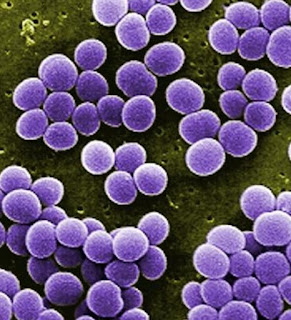Staphylococcal food poisoning is a type of food poisoning caused by infection with the Staphylococcus aureus bacterium.
This disorder can be caused by toxins produced by Staphylococcus aureus bacteria. The toxins are found in contaminated foods.
Staphylococcal enterotoxins are heat- resistant and are not inactivated by cooking. The incubation period for S. aureus food poisoning is between 2 and 4 hours (range 30 minutes to 8 hours).
The bacteria multiply in foods and produce toxins especially if food is kept at room temperature.
Staph food poisoning is characterized by a sudden start of nausea, vomiting, upset stomach and stomach cramps. Most people also have diarrhea. In more severe cases, dehydration, headache, muscle cramping, and changes in blood pressure and pulse rate may occur.
Staphylococcus aureus can also cause serious infections such as pneumonia (infection of the lungs) or bacteremia. Bacteremia is the presence of viable bacteria in the circulating blood.Symptoms usually develop within 30 minutes to 8 hours after eating or drinking an item containing Staph toxin, and last no longer than 1 day. Severe illness is rare.
Typical contaminated foods include custard, cream-filled pastry, milk, processed meats, and fish. The bacteria are also present on the skin, so risk of an outbreak is high if food workers do not wash properly before touching food.
The best way to avoid food poisoning by Staph is to prevent food from being held at an unsafe temperature (between 40°F and 140°F) for more than 2 hours.
Characteristics of staphylococcal food poisoning
Food safety can be defined as the “the avoidance of food borne pathogens, chemical toxicants and physical hazards, but also includes issues of nutrition, food quality and education.” The focus is on “microbial, chemical or physical hazards from substances than can cause adverse consequences.”
The Most Popular Posts
-
Chemical hazard are chemicals that can get into food by improper storage of chemical or chemical containers or by using chemicals improperly...
-
A biological hazards is an agent in food with potential to cause human illness. It is the most significant hazards in our food. Biological h...
-
Some bacteria enter the intestine live, survive the acidic environment of the stomach, and then produce a harmful toxin inside the human dig...
-
If HACCP is not properly applied, then it may not result in an effective control system. This may be due to improperly trained or untrained...
-
Anything foreign to the food can be considered a physical hazard. Dust, dirt, hair, metal shavings and broken glass, for example, are items ...




